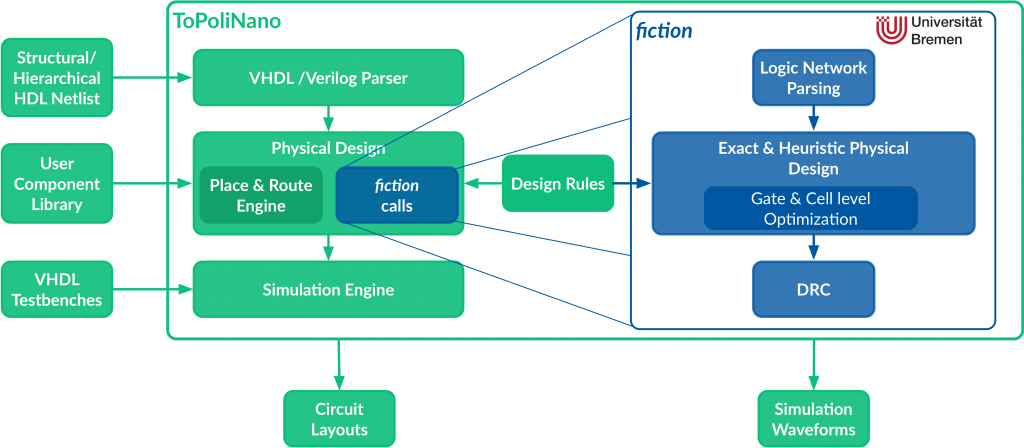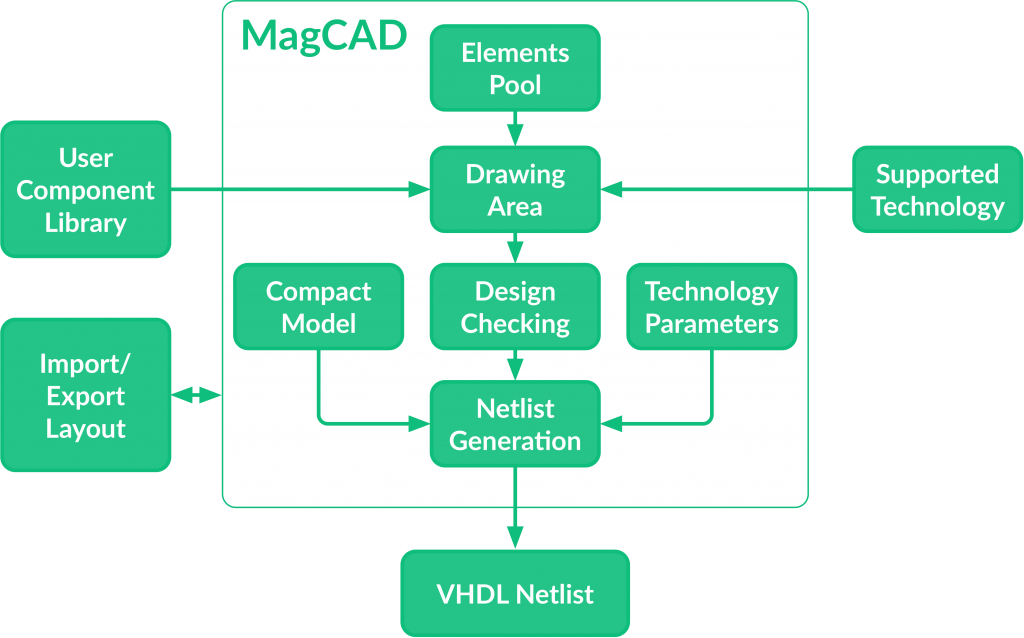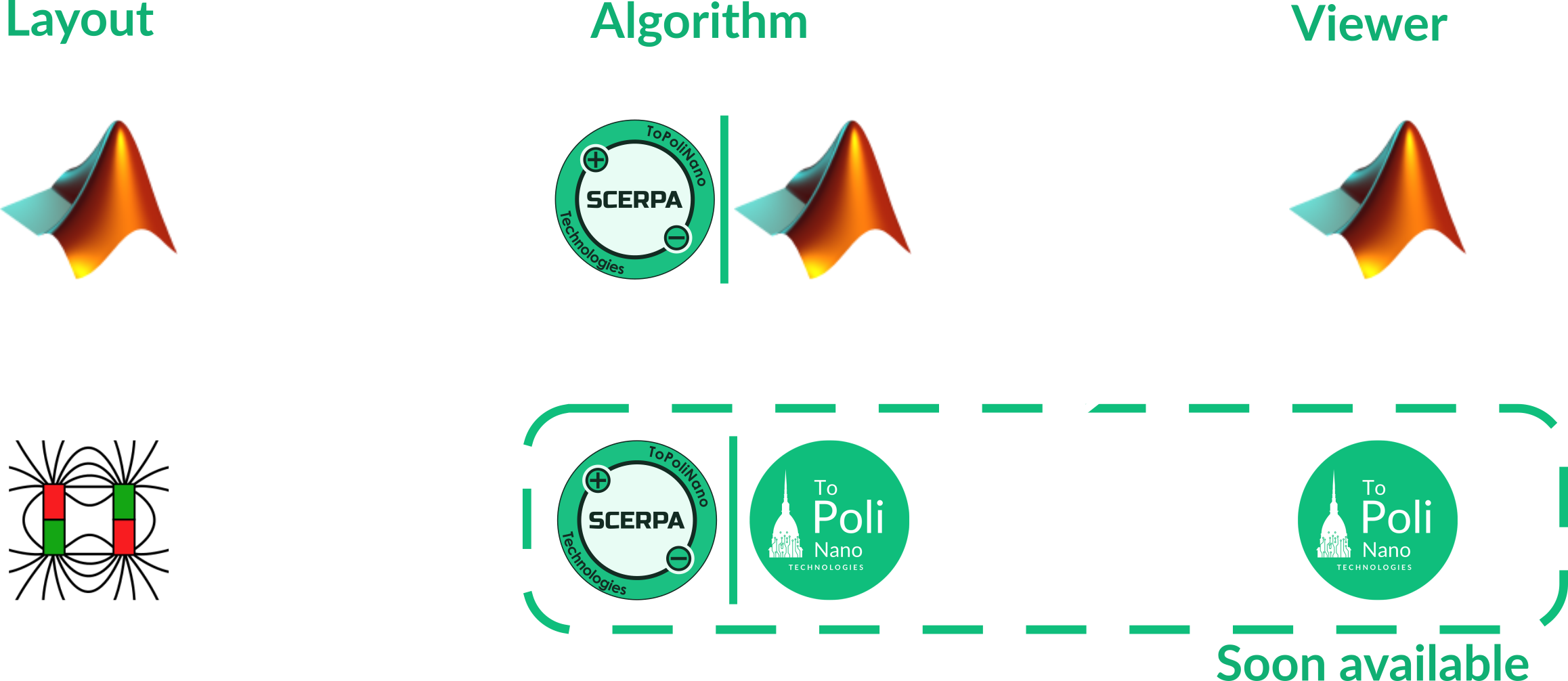ToPoliNano is a EDA tool, conceived and developed at the Politecnico di Torino. The project started in 2012 around the idea of creating a custom system enabling the high-level design approach, already used for standard technologies, also for emerging technologies.

The ToPoliNano framework is composed of two separate software: ToPoliNano and MagCad.
Currently, the ToPoliNano framework fully supports in-plane Nano Magnetic Logic (iNML) technology. Circuits designed with MagCAD, can be used as custom components in ToPoliNano.
Indeed, the custom circuits can be directly instantiated within the VHDL description. On the other hand, automatic-generated layouts generated by ToPoliNano can be re-opened, modified and embedded in larger design by using MagCAD. The whole framework has been developed at the VLSI laboratory at the Politecnico di Torino.
Both tools can be downloaded and used for free.
If you are working on a new, interesting and promising emerging technology and you would like to integrate it on our framework, contact us for a collaboration.
ToPoliNano
The idea of ToPoliNano is to have the possibility of designing and simulate emerging technology-based logic architectures starting from a structural description of the digital circuit. This approach enables the architectural exploration of emerging technologies from an architectural point of view.
The ToPoliNano design flow, follows the same top-down approach usually used with standard digital CMOS designs.

Indeed, it takes as input circuits described with a VHDL/Verilog netlist, and layouts are automatically generated according to the design rules of the target technology. The HDL netlist should be structural or previously synthesized on specific gates available on the target technology. The tool has several optimization algorithms for the Physical Design phase, and the hierarchical floorplanning is fully supported. We integrate fiction design tool developed by the Bremen University.
Besides the layout, ToPoliNano makes it possible to simulate and verify the correct behavior of the generated layout. The simulator embeds both a switch level or physical simulation engine based on the single domain approximation.
ToPoliNano can also take as input, custom layouts generated with MagCAD.
Currently, the ToPoliNano supports in-plane Nano Magnetic Logic technology, but the idea is to extend it to other interesting and promising emerging devices.
We would like to thank Walter Marcel for his support for making possible the integration of fiction in our framework.
MagCad
In digital electronics, RTL design is a common practice. MagCAD is a “smart editor” enabling the graphical design of logic architectures based on emerging technologies.
The architectures developed with MagCAD can be verified, providing a proper testbench, by using standard VHDL simulators as happens with CMOS RTL designs.

MagCAD automatically generates the circuit netlist starting from the drawing. During this procedure, the tool checks the design and associates to each element its corresponding compact model.
The compact models embed physical equations and parameters that are solved at simulation time. The compact models vary according to the selected technology. Currently, two implementations of the Nano Magnetic Logic (NML) technologies are supported: the in-plane NML (iNML) and the perperdicular NML (pNML). MagCAD also supports the graphical design of logic architectures based on molecular Field-Coupled Nanocomputing (molFCN).
The documentation and design guidelines for using MagCAD can be download from here.
SCERPA
The simulation of molecules typically passes through the solution of Schrödinger’s equation using ab initio techniques. However, these simulations are firmly computationally expensive and time-consuming (the simulation of just one molecule can require hours or days). For this reason, it is not feasible to use that method to simulate circuits made of even only tens of molecules.
In the past, we proposed a three-steps methodology named MoSQuiTo. MoSQuiTo addresses the need for a tool to simulate molecular FCN circuits without losing the link with the underlying physics. The three steps of this methodology are:
- ab initio simulations to analyze the molecules of interest stimulated with different electric fields;
- the collected data are processed to extract high-level parameters describing the electrostatic behavior of molecules;
- circuit analyses using the figures of merit extracted at the previous point.
SCERPA is an algorithm that permits the simulation of molecular FCN circuits. Specifically, SCERPA uses the data processed following the MoSQuiTo methodology. Currently SCERPA is written in Matlab and it is intended for development and research purposes. We are also integrating the SCERPA algorithm in the ToPoliNano suite for a more computationally-efficient version of the tool (available soon). The two versions are compatible as indicated in the figure below.


